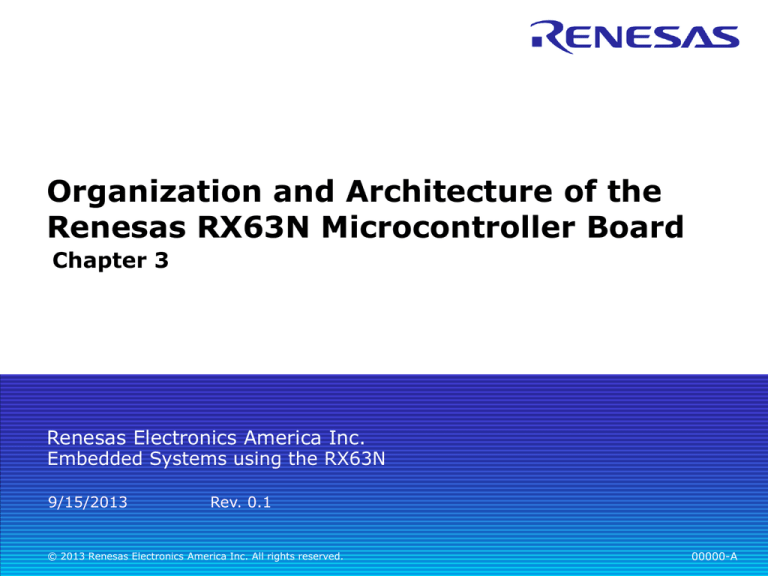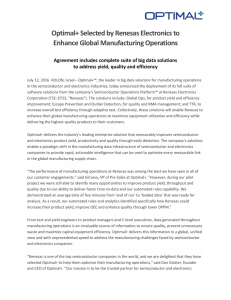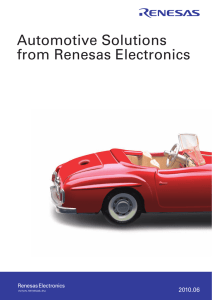
Organization and Architecture of the
Renesas RX63N Microcontroller Board
Chapter 3
Renesas Electronics America Inc.
Embedded Systems using the RX63N
9/15/2013
Rev. 0.1
© 2013 Renesas Electronics America Inc. All rights reserved.
00000-A
In this chapter we will learn:
Basic organization of computers
Architecture of the Renesas RX63N board
Endianness, data arrangement, and bus specification
in RX63N CPU
Data types, operating modes, and memory map of
RX63N CPU
2
© 2013 Renesas Electronics America Inc. All rights reserved.
Introduction to Computer Organization &
Architecture
Computer systems looked at from a hierarchical point of
view
Four basic functions for a computer to perform are:
1.
2.
3.
4.
Data
Data
Data
Data
processing
storage
movement
control
The following illustration outlines how data flows between
the differend components
3
© 2013 Renesas Electronics America Inc. All rights reserved.
Structural Components of a Computer
The four main structural components of a computer are:
CPU: Processes the data and controls the operation of
computer.
Memory: Stores data.
I/O: Moves the data between the computer and the external
environment.
System Interconnection: Provides a mechanism for
transferring data or communicating between components such
as the CPU, main memory, and I/O.
4
© 2013 Renesas Electronics America Inc. All rights reserved.
Central Processing Unit
The Central Processing Unit (CPU) is the most complex
component of the system
The components that make up the CPU are:
Control Unit: Controls the operation of the CPU.
Arithmetic and Logic Unit (ALU): Performs the computer’s
data processing functions.
Registers: Provides internal storage for the CPU. They store
ALU operands.
Interconnections: Provides a mechanism for transferring data
or communicating between components such as the Control
Unit, ALU, and registers.
5
© 2011 Renesas Electronics America Inc. All rights reserved.
Architecture of the Renesas RX63N
The RX63N microcontroller architecture has the following
components:
Central Processing Unit:
– CPU: It is a 32-bit RX CPU with maximum operating
frequency of 100MHz.
– Floating Point Unit (FPU): This unit is a single precision
(32-bit) floating point unit which supports data type
Memory:
– ROM: RX63N variants have the following ROM capacities:
ROMless, 256 Kbytes, 384 Kbytes, 512 Kbytes, 768 Kbytes,
1Mbyte, 1.5,Mbytes, 2Mbytes;
– RAM: Its variants have the following capacities: 64 Kbytes,
128 Kbytes, 192 Kbytes, 256 Kbytes.
– E2 Data Flash: Its capacity is 32 Kbytes.
6
© 2011 Renesas Electronics America Inc. All rights reserved.
Architecture of the Renesas RX63N Cont.
Clock Generation Circuit:
– The clock generation circuit consists of two circuits; a main
clock oscillator and a sub clock oscillator.
– The system clock (ICLK) operates at up to 100 MHz
– The peripheral clock (PCLK) and external bus clock (BCLK)
operate at up to 50 MHz
Reset:
– There are various reset sources available such as: pin reset,
power-on reset, watchdog timer reset, and deep software
standby reset.
Voltage detection circuit:
– When the voltage available on VCC falls below the voltage
detection level (Vdet), an internal reset or internal interrupt is
generated.
7
© 2011 Renesas Electronics America Inc. All rights reserved.
Architecture of the Renesas RX63N Cont.
External bus extension:
– The external address space is divided into nine areas: CS0
to CS7 and SDCS
– A chip-select signal (CS0# to CS7#, SDCS#) can be output
for each area
– Each area is specifiable as an 8-, 16-, or 32-bit bus space
Direct Memory Access (DMA):
– The DMA system consists of three different controllers
– DMA controller: Has four channels and three transfer
modes; normal transfer, repeat transfer, and block transfer.
– EXDMA controller: Has two channels and four transfer
modes; normal transfer, repeat transfer, block transfer, and
cluster transfer.
– Data transfer controller: Has three transfer modes;
normal transfer, repeat transfer, and block transfer.
8
© 2011 Renesas Electronics America Inc. All rights reserved.
Architecture of the Renesas RX63N Cont.
I/O ports:
– The main modules of I/O ports are programmable I/O ports.
– The number of programmable I/O ports depends on the
package
Timers:
– Seven timers are available the controlling the sequence of
events or processes. Some timers are:
– Watchdog timer (14 bits)
– 8-bit timers
– Compare-match timer (16 bits)
Communication function:
– Controllers used for communicating with the outside world,
examples:
– Ethernet controller (10 or 100 Mbps)
– USB 2.0 host/function module (USB 2.0, up to 12 Mbps)
– Serial communication interfaces (13 channels)
– I2C bus interfaces (up to 1 Mbps)
9
© 2011 Renesas Electronics America Inc. All rights reserved.
Architecture of the Renesas RX63N Cont.
A/D converter:
– 12-bit or 10-bit
– Single scan mode and continuous scan mode
D/A converter:
– Two channels, 10-bit resolution
CRC calculator:
– Generates code for data in 8-bit units
Low power consumption:
– Four low power consumption modes are available:
– sleep mode, all-module clock stop mode, software standby
mode and deep software standby mode
Interrupt:
– 187 peripheral function interrupts are available
– 16 external interrupts pins (IRQ0 to IRQ15)
– 16 levels of interrupt priority can be specified
10
© 2011 Renesas Electronics America Inc. All rights reserved.
Architecture of the Renesas RX63N Cont.
Temperature sensor:
– On-chip temperature sensor with 1 channel
– Precision of 1ºC.
Data encryption unit:
– AES encryption and decryption functions
– 128/192/256-bit key lengths
11
© 2011 Renesas Electronics America Inc. All rights reserved.
Terms Frequently Used
12
© 2011 Renesas Electronics America Inc. All rights reserved.
CPU
The CPU used in RX63N/RX631 group of MCU’s supports
high-speed and high-performance.
The instruction set architecture (ISA) has 90 instructions
73 are basic instructions
Eight are floating-point operation instructions
Nine are digital signal processing (DSP) instructions
The CPU has a five stage pipeline for processing instructions
13
Instruction fetching stage
Instruction decoding stage
Execution stage
Memory access stage
Write-back stage
© 2011 Renesas Electronics America Inc. All rights reserved.
Register Set
The RX CPU has 16 general-purpose registers, nine control
registers, and one accumulator used for DSP instructions
The general-purpose registers can be used as data or address
registers
The nine control registers are:
Interrupt stack pointer (ISP)/User stack pointer (USP)
– Holds the value zero after a reset
– 32 bits
Interrupt table register (INTB)
– Points to the addresso f the relocatable vector table
Program counter (PC)
– Points to the address of the instruction that will be executed
next
Processor status word (PSW)
– Indicates the status of the processor, e.g.:
– Result is negative, result is zero, overflow has occurred
etc.
14
© 2011 Renesas Electronics America Inc. All rights reserved.
Register Set cont.
Backup PC (BPC)
– Speeds up the response of interrupts
– Backs up the program counter
Backup PSW (BPSW)
– After a fast interrupt has been generated, the contents of
the processor status word (PSW) are saved in this register
Fast interrupt vector register (FINTV)
– As soon as a fast interrupt is generated, the FINTV register
specifies a branch destination address.
Floating-point status word (FPSW)
– Indicates the result of floating-point operations
15
© 2011 Renesas Electronics America Inc. All rights reserved.
Register Set cont.
16
© 2011 Renesas Electronics America Inc. All rights reserved.
Data Types cont.
The RX CPU supports four types of data:
Integer:
– 8-, 16-, or 32-bit
– Signed or Unsigned
17
© 2011 Renesas Electronics America Inc. All rights reserved.
Data Types cont.
Floating-Point:
– RX Family supports single precision floating-point
computation following the IEEE 754 standard
– There are eight floating point operations available:
– FADD, FCMP, FDIV, FMUL, FSUB, FTOI, ITOF, and
ROUND.
– Single-precision floating-point
– S: Sign (1 bit)
– E: Exponent (8 bits)
– F: Mantissa (23 bits)
18
© 2011 Renesas Electronics America Inc. All rights reserved.
Data Types cont.
Bitwise Operations:
– Operations available:
– BCLR, BMCnd, BNOT, BSET, and BTST
– Notation used:
– “#bit, R ”, which means: corresponding bit in register n
– i.e. #30, R1 = 30th bit in R1 register
– For bitwise operations in memory “#bit, mem.” is used
n
19
© 2011 Renesas Electronics America Inc. All rights reserved.
Endianness
Endianness refers to the arrangement of sub-units such as
bytes within a longer data word, while storing it in memory
Big endian: The most significant byte (MSB) is stored at the
lowest byte address of the memory.
Little endian: The least significant byte (LSB) is stored at the
lowest address of the memory
The RX63N/RX631 Group supports both big and little endian
20
© 2011 Renesas Electronics America Inc. All rights reserved.
Data Arrangement
Data Arrangement in Registers
The least significant bit is the rightmost bit while the most
significant bit is the leftmost bit
21
© 2011 Renesas Electronics America Inc. All rights reserved.
Data Arrangement cont.
Data Arrangement in Memory
Byte (8-bit), word (16-bit), or longword (32-bit)
Different depending on whether little or big endian is used
22
© 2011 Renesas Electronics America Inc. All rights reserved.
Bus Specification
CPU bus
Instruction bus and Operand bus:
– Connects the CPU to on-chip memory (RAM and ROM)
– Operates in synchronization with the system clock (ICLK)
Memory bus
Memory bus 1 and 2:
– Connected to the on-chip RAM
Internal main bus
Internal main bus 1:
– Connected to CPU
Internal main bus 2:
– Connected to DMACA, DTC, EDMAC, and on-chip RAM and
ROM
23
© 2011 Renesas Electronics America Inc. All rights reserved.
Description of Buses
CPU Buses
Fetches instructions for the CPU and accesses operands
Programming and erasure is handles by the internal peripheral
bus
Bus-access operations can proceed simultaneously, e.g. parallel
access to on-chip RAM or ROM
Memory bus
Accesses on-chip ROM and RAM
Internal main bus
Internal main bus 1 is used by the CPU and internal main bus 2
is used by other bus-master modules such as DTC, DMACA, and
EDMAC.
Bus master priority:
24
© 2011 Renesas Electronics America Inc. All rights reserved.
Description of Buses cont.
Internal peripheral bus
The table below lists the six internal peripheral buses and what
peripheral modules they are connected to
25
© 2011 Renesas Electronics America Inc. All rights reserved.
Description of Buses cont.
External Bus
Arbitrates requests from the internal main bus 1, 2 and
EXDMAC and decides the master
The order of priority is, from high to low:
– EXDMAC
– Internal main bus 2
– Internal main bus 1
Bus Error Monitor Section
Generates an interrupt whenever an error is detected on the
bus
Some errors are:
– Illegal address access error
– Access to areas for which operation has been disabled
– Timeout error
– Happens after 768 cycles if the bus access is not
completed
26
© 2011 Renesas Electronics America Inc. All rights reserved.
Pipelining
Pipelining is an important technique used to make fast CPUs
A pipeline consists of several stages which allows the
instruction throughput to increase
A pipeline stage cannot be any faster than the slowest stage
If for example the execution stage takes more time than the
memory access stage, then performance degrades to the
slowest stage
The RX CPU is based on a five-stage pipeline:
Instruction Fetch Stage (IF Stage):
– CPU fetches 32/64 bit instructions from the memory.
– PC is incremented by 4 or 8 since the instructions are 4 or 8
bytes long
Instruction Decode Stage (ID Stage):
– Instructions are decoded and converted into microoperations.
27
© 2011 Renesas Electronics America Inc. All rights reserved.
Pipelining cont.
Execution Stage (E Stage):
– Two types of calculations take place in this stage
– Normal ALU operations:
– Add, sub, compare, and logical operations
– Memory address calculations
Memory Access (M Stage):
– Memory is accessed for either fetching an operand from the
memory or storing an operand in the memory.
Write-back stage (WB stage):
– The last stage of the pipeline writes data into the register
file
28
© 2011 Renesas Electronics America Inc. All rights reserved.
Pipeline Operational Hazards
Ideally, each pipeline stage should take the same amount of
time to process the instruction
Unfortunately, ideal conditions are hard to achieve and
hence stalls are created in the pipeline and performance is
degraded
Hazards prevent the next instruction from executing at the
next cycle and reduce the performance of the pipeline
Structural hazard:
Arises from resource conflicts when the hardware is not capable
of supporting multiple instructions simultaneously in an
overlapped manner
For example a single memory that is being accessed
simultaneously in both the instruction fetch stage and the
memory stage
29
© 2011 Renesas Electronics America Inc. All rights reserved.
Pipeline Operational Hazards cont.
Data hazard:
Arises when an instruction depends on the result of a previous
instruction, e.g.:
– Instruction 1: A+B = C
– Instruction 2: C+D = F
– Instruction 2 cannot be executed before instruction 1 has
completed since the instruction is dependent on the value C
calculated in instruction 1
Control hazard:
Also known as branch hazard
Arises from pipelining of branches and other instructions that
change the program counter
For example, when a set of instructions are control dependent
on the branch condition, and what value the PC will take is not
known until the execution stage or decode stage
30
© 2011 Renesas Electronics America Inc. All rights reserved.
Operating Modes
There are six operating modes with two types of operatingmode selections
Boot Mode:
– Provided for the flash memory
– Functions the same way as single-chip mode except for data
write/erase function to the flash memory
USB Boot mode:
– Provided for the flash memory
– Functions the same way as single-chip mode except for data
write/erase function to the flash memory
31
© 2011 Renesas Electronics America Inc. All rights reserved.
Operating Modes cont.
Single-Chip Mode:
– On-chip ROM can be set to either enabled or disabled
– All I/O ports are accessible and the external bus is always
disabled
32
© 2011 Renesas Electronics America Inc. All rights reserved.
Operating Modes
The following illustration outlines the mode transitions
depending on the settings of the MD and PC7 pins
33
© 2011 Renesas Electronics America Inc. All rights reserved.
Memory Organization
Byte Addressing vs. Word Addressing
By using N address lines we can address 2^N distinct
addresses, numbered 0 through 2^N - 1.
Logical layout of a block of memory (1)
Byte addressing (2)
Word addressing (3)
3.
Memory Map
2.
1.
This microcontroller has a 4-Gbyte address space, which ranges
from0000 0000h to FFFF FFFFh.
34
© 2011 Renesas Electronics America Inc. All rights reserved.
I/O Registers
This section focuses on preventive measures that should be
taken while using I/O registers
In some cases, after writing into I/O registers, you must
check whether the write operation is completed
The CPU could also behave differently and could lead to
unpredictable results
The correct way to handle each situation is to wait until the
write operation is completed and by following these steps:
35
Write to an I/O register.
Read the value from the I/O register to a general register.
Execute the operation using the value read.
Execute the subsequent instruction.
© 2011 Renesas Electronics America Inc. All rights reserved.
What we have covered
36
Architecture of the Renesas RX63N
CPU Specifications and Instruction Set
Register Set
Data Types
Data Arrangement
Bus Specifications
Pipelining and Pipeline Hazards
Operating Modes
Organization of Registers and Memory
How I/O Registers should be accessed
© 2011 Renesas Electronics America Inc. All rights reserved.
Renesas Electronics America Inc.
© 2013 Renesas Electronics America Inc. All rights reserved.



